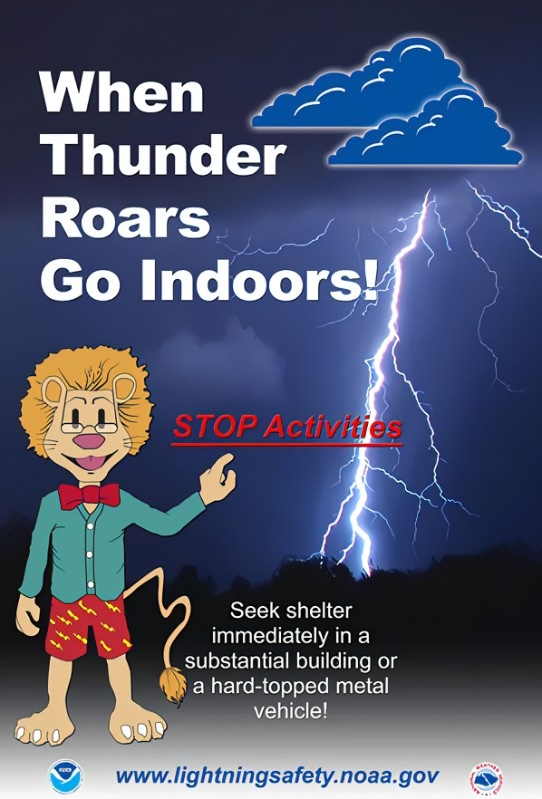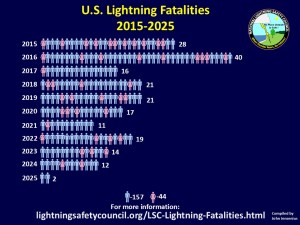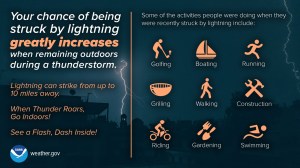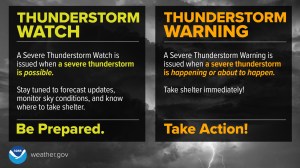Lightning as a serious
danger can be underestimated
Published 1:35 pm Monday, June 16, 2025

- Felecia Bowser, Meteorologist-in-Charge at the National Weather Service in Tallahassee, said, “We have a saying at the National Weather Service when it comes to lightning. ‘When Thunder Roars, Go Indoors!’.”
MOULTRIE – It’s thunderstorm season in South Georgia, which brings the possibility of heavy rain, straight line winds and hail. However, where thunder sounds, lightning follows and it seems like people often underestimate it as another dangerous product of thunderstorms.
According to the National Lightning Safety Council, from 2015 to present, there have been 201 fatalities due to lightning in the US. There were 157 men and 44 women killed by lightning in that time span.

“Unfortunately, the vast majority of lightning victims are male, which you can see in the graphic above,” said Felecia Bowser, Meteorologist-in-Charge at the National Weather Service in Tallahassee.
The American Red Cross cautions that lightning travels at speeds of up to 300 miles per second and anything tall like a tower, tree or person can become a path for the electrical current.
Trending
“The threat that someone will be struck by lightning depends on their behavior when thunderstorms are in the area,” the lightning safety council states. “While some people move inside at the first signs of a thunderstorm, many people wait far too long to get to a safe place.”
Felecia Bowser, Meteorologist-in-Charge at the National Weather Service in Tallahassee, said, “We have a saying at the National Weather Service when it comes to lightning. ‘When Thunder Roars, Go Indoors!’”
Increased risk
The National Lightning Safety Council gives unsafe behavior examples that people put themselves at risk with during a thunderstorm.
 • Some wait until the thunderstorm is overhead and it starts to rain before getting to a safe place.
• Some wait until the thunderstorm is overhead and it starts to rain before getting to a safe place.
• Others, due to poor planning, are caught outside and can’t get to a safe place.
• Some put themselves at risk by touching items that could become electrified by a nearby lightning strike.
Trending
• Many people go outside too soon after the storm has seemingly passed.
The Georgia Emergency and Homeland Security Agency states that a typical thunderstorm is 15 miles in diameter and lasts an average of 30 minutes. It gives the “30/30 Lightning Safety Rule,” as, “Go indoors if, after seeing lightning, you cannot count to 30 before hearing thunder. Stay indoors for 30 minutes after hearing the last clap of thunder.”
“Many people are unaware that lightning can strike as far as 25 miles away from its parent storm. So during your outdoor activities, if thunder is heard or if lightning is seen, use caution and seek shelter,” said Bowser.
“It is important to understand that there is no safe place outside when thunderstorms are in the area. If you hear thunder, you are likely within striking distance of the storm,” the National Lightning Safety Council also advises. “The best way for you to protect yourself from lightning is to avoid the threat. You simply don’t want to be caught outside in a storm.”
Taking shelter
Just like hurricane watches and warnings, the National Weather Service issues the same for severe thunderstorms.
A watch means there’s a potential for one to impact the area within the next six hours.  A warning means one is occurring or will likely occur soon and it’s advised to take shelter immediately.
A warning means one is occurring or will likely occur soon and it’s advised to take shelter immediately.
When taking shelter, both the Georgia Emergency Management and Homeland Security Agency and the National Lightning Safety Council offer these cautions.
• Avoid taking a shower or a bath during a thunderstorm. Plumbing and bathroom fixtures can conduct electricity.
• When inside, do not touch anything that is plugged into an electrical outlet or corded phones.
• Keep away from outside doors and windows and do not lie on a garage floor.
Just in case
In the event that someone is struck by lightning, the American Red Cross advises that it can “flash” over a person’s body or it can travel through blood vessels and nerves to reach the ground.
“A person who is struck by lightning is not electrified. So, you will not be electrocuted if you touch them. It is safe to give first aid immediately,” the American Red Cross also states.
The electrical energy can cause burn injuries and cardiac arrest. When the force of the lightning strike is sufficient to throw the person through the air, traumatic injuries like fractures or dislocations can result.
Call 911 immediately and render first aid. Start CPR, if necessary, or use an Automated External Defibrillator, if available.
Bowser said the National Lightning Safety Awareness Week is from June 22-28, this year. The purpose of Lightning Safety Awareness Week is to educate and raise awareness about the hazards of lightning, she said. Supporters want to lower the number of deaths and injuries caused by lightning strikes, she said.
“The best way to protect yourself and your family from the dangers of thunderstorms is to be prepared. If you have outdoor plans, be sure to familiarize yourself with the latest weather forecast before heading out. Consider taking a portable NOAA Weather Radio or AM/FM radio with you, she said. “Upon arriving on-site, determine where you will seek shelter in the event of a thunderstorm and how long it would take to reach that shelter. A sturdy, enclosed structure with plumbing and electrical wiring is safest, but if one is not available, most enclosed metal vehicles are safe alternatives.”
For more information go to the National Lightning Safety Council website at http://lightningsafetycouncil.org/LSC-Safety-Introduction.html.




